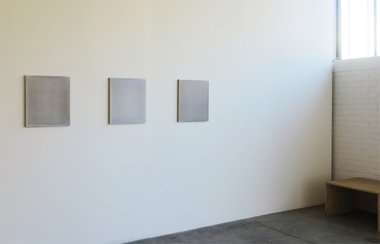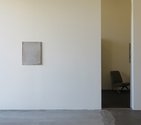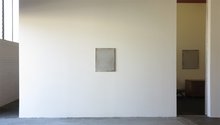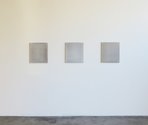John Hurrell – 15 May, 2013
The squeegeed works (three of them) have very thin paint, so thin that despite creamy encrustations at the edges, the greyish colour could almost be mistaken for graphite. The paint used is interference paint, a variety that subtly alters chroma according to the angle of the light raking across its surface.
Leigh Martin is usually known for his brightly saturated, toxic-looking viscous paintings made of yacht hull lacquer, but instead this exhibition is quite different. It features more conventional studio materials: a very thin, white acrylic, a watery blend of poured paint (a la Dale Frank) mixed with a Robert Ryman palette - but involving no brushes or stickiness. Like a saline or icey form of sandshoe polish.
Within the nine works are three varieties of painting - all on a dark beige/khaki coloured linen. Two types involve poured paint, the other uses a squeegee.
The two poured varieties differ in their treatment of surface. One is larger and with a uniform milky white skin that has curved negative ‘bites’ sporadically eating away around the stretcher edges. Overall they look like cartographies - newly discovered landforms seen from the air. Sometimes there are hints of mountain ranges.
The smaller type has a mottled texture, either granular with a field of specks scattered across the surface, or else cellular and botanical, reminiscent of veiny leaf forms or underwater plant life. Martin has used gravity to move the runny paint around, tilting the stretcher to control the fluid’s direction. These canvases are rich in organic pattern, evocative forms that appear to be on the verge of dissolving - as if caverns in limestone caves or packed snow. The modulated white is highly seductive when positioned on the linen.
The squeegeed works (three of them) have very thin paint, so thin that despite creamy encrustations at the edges, the greyish colour could almost be mistaken for graphite. The paint used is interference paint, a variety that subtly alters chroma according to the angle of the light raking across its surface. It is closer to pearlescent (or opalescent) than iridescent, being delicate and restrained - as opposed to saturated and garish. A strange mauve wash hovers within the weave of the linen, taking on a faint greeny tinge, this depending on the spectral nature and direction of the light.
The globs of thick buttery colour which cling to the perimeter, are mainly on the vertical edges, the evanescent mauve dominating the horizontal ones. Martin’s use of a squeegee connects these works in Auckland with say the paintings of Noel Ivanoff, except in Martin’s case (and unlike Ivanoff who works on smooth aluminium) there is a subtle grain, an awareness of the linen weave, resulting in a barely detectable streaky mist. An understated contrast to the drama of the poured ‘landscapes’.
John Hurrell
Recent Comments
John Hurrell
Obviously we are not going to agree. Apart from the oddness of your adding 'jam' to 'beauty' when surely both ...
Owen Pratt
We seem to agree that these works are more concerned with beauty and less with the brave new world. A ...
John Hurrell
I don't separate mind from the body (or stomach or mouth) - they are interconnected - for some art can ...




 Two Rooms presents a program of residencies and projects
Two Rooms presents a program of residencies and projects Advertising in this column
Advertising in this column



This Discussion has 4 comments.
Comment
Owen Pratt, 7:17 p.m. 21 May, 2013 #
Two words jump out at me, 'landscape' and 'buttery'; both bring the viewer to the work but may obscure the artist's intent, if indeed there is one.
The panels are oriented slightly to the vertical so 'skyscape' may be more ethereal than a horizontally orientated 'landscape'; this fits with the interest in reflection and refraction of the media. Perhaps finding any 'scapes' in these works is an anathema to an artist trying to actualise the surface of the canvas, if this is Martin's intent.
'Buttery' is the one that really puts the blood pressure up. This is the language of the food reviewer or, save us, the real estate agent. It seems like a soft sell rather than a hard critique. If you were feeling less generous could it be said that the paint is larded on with a spatula?
Do Martin's interests leave us with something of the sublime, raw and romantically powerful or are these works merely beautiful, carefully crafted from the Old World, with a few novel techniques, in the best of taste?
John Hurrell, 8:05 p.m. 21 May, 2013 #
I don't separate mind from the body (or stomach or mouth) - they are interconnected - for some art can get your stomach rumbling or mouth watering, by virtue of its textural, morphological or colour associations. Certain art experiences remind you of bodily pleasures and in fact generate more. In this country's history of painting I've wanted to eat Robert McLeod's seventies paintings with a spoon, and (overseas) still so desire the current paintings of American artist Jonathan Lasker.
Such sensations are very real and (I believe) common. If you, Owen, want to be a dour Puritan who hates pleasure and sensuality, Good Luck to you, but don't expect me to agree. I'm not claiming this is the only way of looking at these works, but they don't seem related to the sublime either. They are too subtle and too small to have that sort of emotional and visceral response - where the viewer is swept away.
Owen Pratt, 11:37 a.m. 22 May, 2013 #
We seem to agree that these works are more concerned with beauty and less with the brave new world. A bit of hot buttered crumpet perhaps.
I like my crumpets with a bit of jam.
John Hurrell, 8:35 p.m. 22 May, 2013 #
Obviously we are not going to agree. Apart from the oddness of your adding 'jam' to 'beauty' when surely both are sweet, I consider art without overt political content not in any way lacking. There is room for many sorts of art.
BTW there is a great book by Lawrence Weschler of conversations with David Hockney http://search.aucklandlibraries.govt.nz/?q=lawrence%20Wescler&refx=&uilang=en where in the foreword he talks of his friendship with both Hockney and Robert Irwin who have two very different practices, one focussing on 'content' in the 'real' world, the other examining the nature of perception. Each dislikes the other's work, but there is no reason logically why one cannot enjoy both. Indeed Weschler has written separate enthusiastic books of dialogues with both.
Participate
Register to Participate.
Sign in
Sign in to an existing account.